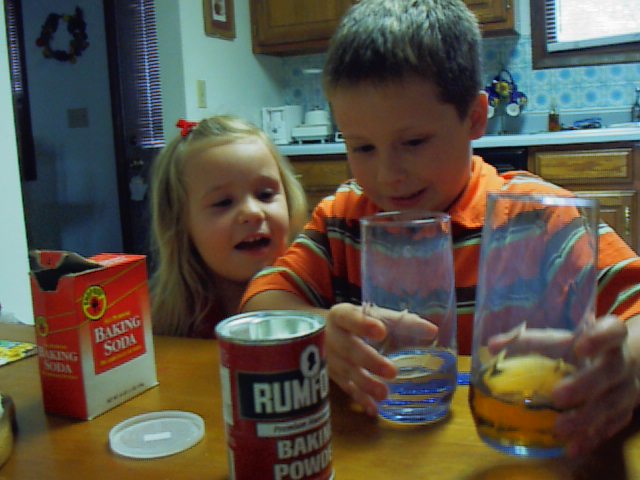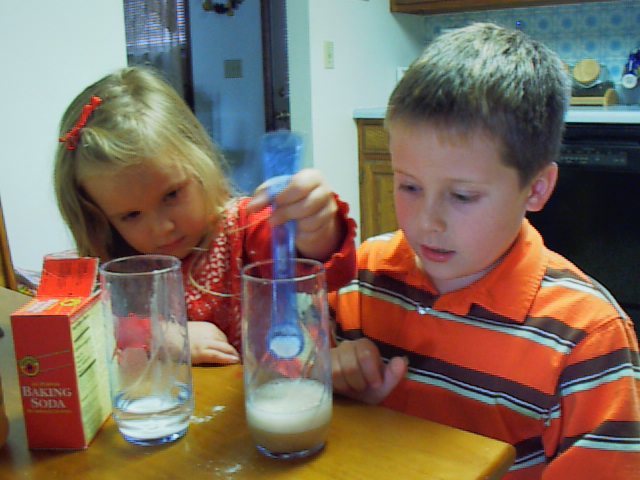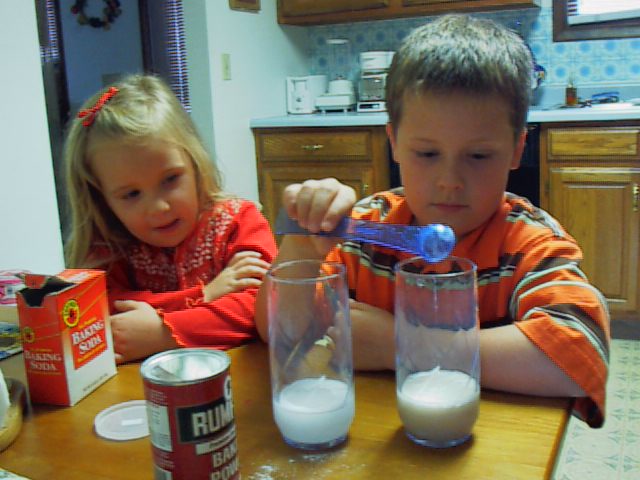
By Libby and Robert Strong and Richard Pollack
Cool, fall temperatures may mean more time indoors, but there is plenty to explore, especially in your kitchen. What is nicer than baking something yummy with your mom or dad and smelling that wonderful aroma throughout the house? Imagine coming in from a crisp walk or bike ride and warming up with some baking chemistry.
Before experimenting in the kitchen, be sure an adult is present to help. Hot temperatures in the oven need to be supervised and someone tall probably needs to help retrieve mixing bowls, cookie sheets, and other items.
Did you ever wonder what is going on when cookies or cakes rise?
What happens to turn that scrumptious lump of cookie dough into a chewy
or soft cookie?
What makes those little bubbles in the cake or cookie batter
as the confections bake? All of these questions are related and can
be explored in the following activity (adapted from Science Experiments
You Can Eat by Vicki Cobb).
Experiment: Can we Change the “Rise” of Cupcakes?
You will need the following materials:
A: 4 paper muffin cups
B: A muffin pan
C: 1.0 cup (250 ml) cake flour
D: 0.5 cup (125 ml) sugar
E: 0.5 teaspoon (about 2.5 ml) baking powder
F: 0.25 teaspoon (just over 1 ml) salt
G: 1.0 egg
H: 0.25 cup (about 63 ml) butter a room temperature
I: 0.25 cup (about 63 ml) milk
J: 1.0 teaspoon (about 5 ml) vanilla extract
K: Electric mixer (or lots of energy)
L: Two mixing bowls
M: Mixing spoons
Procedure:
Step 1: Preheat oven to 350 degrees F (177 degrees C).
Step 2: Put baking cups in muffin pan.
Step 3: Measure the “dry ingredients” cake flour, sugar, baking
powder, and salt.
Mix these ingredients and set aside.
Step 4: In a separate bowl measure and mix the “wet ingredients” - single egg, room temperature butter, milk, and vanilla extract together. An electric mixer (on lowest speed) works well for this.
Step 5: Carefully and slowly stir / fold the dry ingredients into
the wet ingredients until the mixture is smooth (the lumps of dry ingredients
are all dissolved).
This mixture is now the cupcake batter.
Step 6: Pour the cupcake batter into the baking cups in muffin pan until the baking cups are about 2/3 full. Place these into the oven for about 15 minutes.
Try using the same cupcake recipe, changing only the amount of baking powder. See what differences it makes to the cupcake to use 1.0 teaspoon (about 5 ml) of baking powder, then try changing the amount to 1.5 (about 7.5 ml) of baking powder.
Which cupcake recipe made the fluffiest cupcakes?
Which cupcakes rose more, which rose less? Why do you think there was a difference in the cupcakes?
Experiment: How Do Liquids Affect “Fizz”?
a two part experiment
You will need the following ingredients:
A: Baking Soda
B: Vinegar (white or cider vinegar)
C: Water
D: Baking powder
E: 2 or 4 juice glasses or water glasses
F: Measuring spoons (teaspoon needed)
G: Measuring cup (need quarter cup measurements)

Experimental Procedure:
First Part:
Step 1: Measure 0.25 cup (about 63 ml) of tap water and pour into a glass.
Step 2: Measure 0.25 cup (about 63 ml) of vinegar (white or cider) and pour into a second glass.
Step 3: Measure and sprinkle in each glass 1.0 teaspoon (about 5 ml) of baking soda into each glass and carefully observe if anything happens in each glass and record your observations.

Describe to your mom and dad, little brother or sister, or friends what you think happened in each glass.
Second Part:
A: Next, use two different glasses or thoroughly rinse the glasses you just used for the baking soda First Part of the Fizz Experiment.
B: Measure 0.25 cup (about 63 ml) of tap water and pour into a glass.
C: Measure 0.25 cup (about 63 ml) of vinegar (white or cider) and pour into a second glass.
D: Measure and sprinkle in each glass 1.0 teaspoon (about 5 ml) of baking powder into each glass and carefully observe if anything happens in each glass and record your observations.
As an extra extension for this second part of the Fizzy Experiment, see if there is a difference in using warm water and warm vinegar versus cold water and cold vinegar. How does this experiment compare using different temperatures of liquids?

To find out more about baking soda and baking powder visit our website at
http://smartcenter.org/ovpm/bakingpowder&soda
Reflections on “American” Foods
As you sit down to enjoy Thanksgiving dinner, pause a moment to think
about the many foods that are native to the Americas .
Some of the Native American foods may be obvious to you, turkey,
corn, mashed potatoes, sweet potatoes, and pumpkin pie. What are
other common foods we eat that are Native American in origin? Discuss
it at the dinner table. For more information see:
http://smartcenter.org/americanfoods
What’s Up? Magnificent Mars Still in the Sky
Last month, October 2005, the planet Mars was at its closest approach
to the Earth since August 27, 2003 . Throughout October, Mars grew
brighter (to the eye) and larger (in a telescope) than usual.
Mars viewing will be good for the rest of November as it slowly
recedes from the Earth. For more information on upcoming free astronomy
events at Brooke Hills Park , visit our website:
http://smartcenter.org/whatsup
Libby and Robert Strong work at the West Liberty State College SMART-Center.
Libby is the director of the West Virginia Handle On Science Program that
brings hands-on science kits into the classrooms of K-6 grade public schools
in the five counties of West Virginia ’s Northern Panhandle. Robert
is the Director of the WLSC SMART-Center, the hands-on science center of
northern West Virginia .
Richard serves as the Assistant Program Coordinator at the SMART-Center.
Libby, Robert, and Richard invite you to visit the SMART-Center website
at http://smartcenter.org